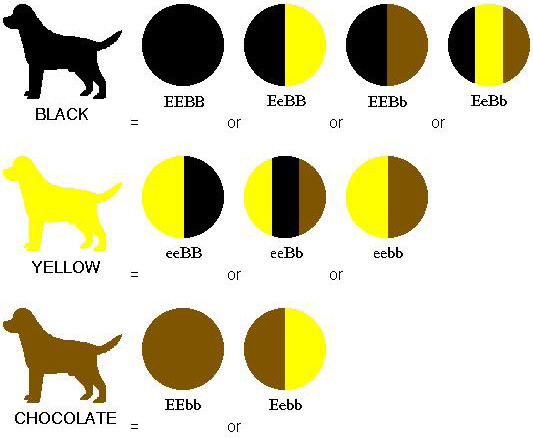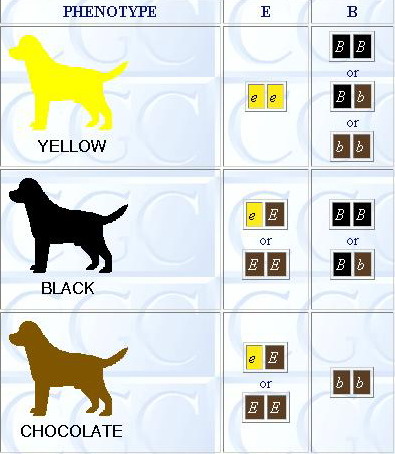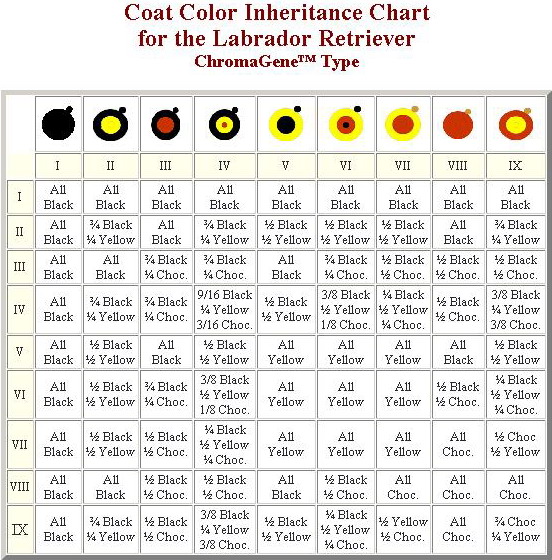拉布拉多有三种颜色,黑色,黄色,巧克力色。
黑色,黄色,巧克力色是拉拉毛色的表现型。 (通常所见所闻的奶白色到深黄色甚至狐红色都属于黄色拉拉。)
单是从一只拉拉的毛色上,我们无法判断出他的毛色基因型 , 下图说明的正是这个问题。
黑拉拉的毛色基因型有四个可能性:
1~不带别的毛色因子
2~带有黄色因子
3~带有巧克力色因子
4~带有黄色和巧克力色因子
黄拉拉的毛色基因型有三个可能性
1~带有黑色因
2~带有黑色和巧克力色因子
3~带有巧克力色因子
巧克力色拉拉的毛色基因型有二个可能性
1~不带别的毛色因子
2~带有黄色因子

拉拉的毛色主要由近二十个基因座控制的,但对于通常来说拉拉大多数的基因座的基因型是一样的,不同的只有E和B,所以这里主要讲E和B。
先讲基因座E——基因座E可以控制真黑素,它有两个等位基因E和e。E是显性的,真黑素出现(黑色或巧克力色)。e是隐性的,真黑素不出现(黄色)。
这二个等位基因又有三种组合:
EE = 黑色或巧克力色拉拉,无黄色因子
Ee = 黑色或巧克力色拉拉,但带有黄色因子
ee = 黄拉拉
最后讲基因座B——基因座E可以控制黑色素,它有两个等位基因B和b。B是显性的,黑色素出现(黑色)。b是隐性的,黑色素不出现(巧克力色)。
因为 黄色(ee) 是由隐性的epistatic gene产生的, 能blotting out the expression of the black or chocolate genes.所以,当黄色(ee)不出现的时候(EE/Ee):
BB = 黑色拉拉,无巧克力色因子
Bb = 黑色拉拉,有巧克力色因子
bb = 巧克力色拉拉,无黑色因子
当黄色(ee)出现的时候:
BB = 黄拉拉,带黑色因子
Bb = 黄拉拉,带黑色和巧克力色因子
bb = 黄拉拉,带巧克力色因子
因为每个等位座都有三种组合的可能性,当两个基因座组合起来的时候,三三得九,所以拉拉一共有9个毛色基因型。在明白是面这些"代码"之后,下面这个图就很好理解了.
例如:
基因是eeBB的拉拉-这是一个黄色的拉拉-但是它带有黑色因子
基因是EEBB的拉拉-这是一个黑色的拉拉-不带有别毛色因子.

这个图是两只拉拉交配色系遗传图
拉拉一共有9个毛色基因型-交配时-一共有九九八十一种组合——
图中:
I EEBB 黑拉,
II EeBB 黑拉,带黄色因子
III EEBb 黑拉,带巧克力色因子
IV EeBb 黑拉,带黄色因和巧克力色因子
V eeBB 黄拉,带黑色因子
VI eeBb 黄拉,带黑色因和巧克力色因子
VII eebb 黄拉,带巧克力色因子
VIII EEbb 巧克力色拉拉
IX Eebb 巧克力色拉拉,带黄色因子
另外: 黄黄拉拉配黄黄拉拉只能生出黄拉拉,VII型拉拉是失格的。
 说到毛色不得不说一下Dudley拉拉,就是上贴中的VII型拉拉。这种拉拉是带隐性纯合子基因eebb的黄拉拉,因为他们没有黑色素,所以鼻子嘴唇和眼眶会是巧克力色的,眼睛的的颜色也比较淡。 说到毛色不得不说一下Dudley拉拉,就是上贴中的VII型拉拉。这种拉拉是带隐性纯合子基因eebb的黄拉拉,因为他们没有黑色素,所以鼻子嘴唇和眼眶会是巧克力色的,眼睛的的颜色也比较淡。
虽然按照现行的标准,这种拉拉在赛场是失格的,但没有证据证明Dudley拉拉与疾病有关,并不影响Dudley拉拉成为一只好的伴侣犬。
这就是Dudley拉拉:.jpg)
说了Dudley拉拉又忍不住要说一个"银拉拉"。
"银色拉拉(silver labs)"到现在还是一个很有争议性的话题.
繁殖者是这样对它的描述的:灰色的被毛(有点像威玛的颜色),灰色的指甲鼻子爪垫 6-8个月以前,眼睛是浅蓝色的,
成年以后变成淡黄色(比一般的巧克力色拉拉要淡一半)。
对于"银色拉拉"的出现,AKc和美国拉拉俱乐部在1987年曾联手调查过. 双方都认为这些拉拉是纯种的,2009年4月23日 (四) 13:09 (CST) 。但是在登记的时候,它们仍属于巧克力色系的。
银色拉拉的起因,现在还不能确定:
有些人认为银色拉拉的祖先曾经和威玛杂交过,不过已经肯定"银色拉拉"的父母都是巧克力色的。翻查以前的记录,在四五十年代的记录里的确有关于出现"银色拉拉"的记载。
有些人认为"银色拉拉"在健康上和普通拉拉没有多大分别, 所以国外有很多"银色拉拉"的专门繁殖者,但是也有些人认为不应该繁殖"银色拉拉",他们认为这是个错误(a serious fault in the breed)。
从遗传学上分析,银拉拉的成因,主要有下面几种说法:
说法一: 在D locus上"dd"稀释了黑色素或是巧克力色素。
The first explanation would attribute this rare color in the breed to the D locus. Recall that the alleles of the D locus modify the color determined by the B locus. Therefore, if a dog is homozygous or heterozygous for black at the B locus, presence of homozygous recessive "d" at the D locus would dilute the black pigment to appear blue. Alternatively, if a dog is homozygous for chocolate at the B locus, presence of homozygous recessive "d" at the D locus would dilute the chocolate pigment to appear silver. The absence of the corresponding "blue" phenotype in the breed, however, would seem to argue against this explanation.
说法二: C locus 上的基因突变。
Another explanation for silver coat color in Labs would attribute this color to the C locus. There is an allele mutant at the C locus that has been determined to cause silver coat color and blue eyes in dogs. The "cb" allele is believed to be a type of albinism. Since alleles at the C locus influence red pigment only, effects of the "cb" allele should only be observed in dogs homozygous "e" at the E locus. Therefore, a silver Lab would not only have to receive the yellow allele from both parents, but also receive the silver allele from both parents (which is recessive to the common "cch" allele). This allele would explain the silver-toned modification of coat observed in yellow Labs in the presence of the recessive "e" allele, however it would not explain the eumelanin modification in the black or chocolate-based silvers (since the C locus alleles primarily dilute phaeomelanin).
说法三: E基因突变失去部分功能。
Likewise, the possibility of a "partial loss of function" mutation that may have occurred in the dominant "E" allele resulting in muted tones of eumelanin would not explain the modification of phaeomelanin (yellow).
说法四: 因突变或杂交引起的"E+" 基因。
An alternative explanation for explaining the modification of both eumelanin and phaeomelanin again returns to the wild-type/gain-of-function "E+" allele that encodes for a normal functioning Mc1 receptor. If this allele either occurred as a spontaneous mutation or was introduced into the breed through interbreeding, this might explain the modification occurring in all three colors, particularly when one considers the following: When one traces the pedigrees of some silver Labs, one finds a history of other color oddities occurring in some related bloodlines to the silver Labs. Occurrences of "black-casting" in chocolates, muted chocolate coloration ("card-board box" coloring), as well as the occasional occurrence of black puppies being whelped from two chocolate parents suggests that these "chocolates" were probably not chocolate at all but rather E+ yellows. As such, it is conceivable that the Agouti alleles could produce an intense red pigment resulting in deep red (interpreted as chocolate especially in the absence of "saddling" modifiers) or diluted, muted red (card board box color) due to further modification by the alleles of the C locus). In black Labs, an ayayEE+ geneotype could produce a muted black color (because of the presence of both receptor types) especially if the alleles at the C locus were cch, thus resulting in a deep charcoal, silvery coat appearance. This suggests a possible role of E+ for the silver coloration as well as for a multitude of other coat color variants that occasionally occur in the breed.
 
|









 说到毛色不得不说一下Dudley拉拉,就是上贴中的VII型拉拉。这种拉拉是带隐性纯合子基因eebb的黄拉拉,因为他们没有黑色素,所以鼻子嘴唇和眼眶会是巧克力色的,眼睛的的颜色也比较淡。
说到毛色不得不说一下Dudley拉拉,就是上贴中的VII型拉拉。这种拉拉是带隐性纯合子基因eebb的黄拉拉,因为他们没有黑色素,所以鼻子嘴唇和眼眶会是巧克力色的,眼睛的的颜色也比较淡。.jpg)

